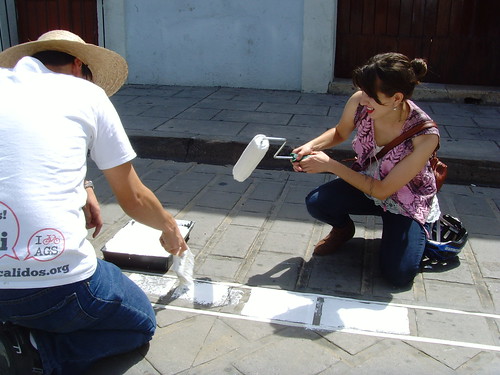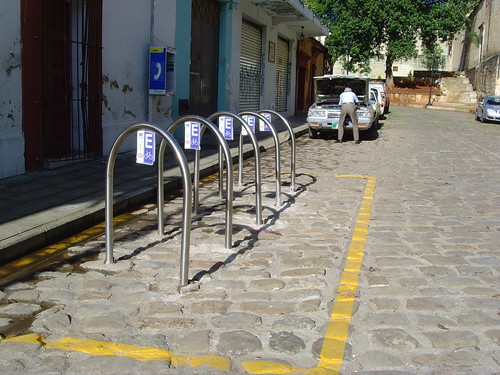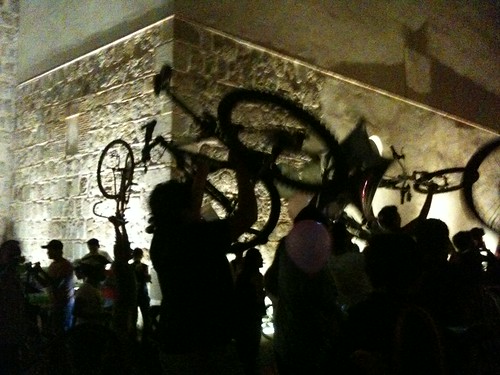
Painting a new bike lane in Oaxaca City
Imagine Critical Mass — but you’ve raised money to pay the police to escort the ride — and hundreds of people show up, including whole families — and everyone is singing and chanting and having a grand time — and it happens twice a week.
That’s how it is in Oaxaca, Mexico. The rides are called Paseo de Todos — the ride for everyone — and they happen on most Wednesday and Friday nights. The one I went on happened to be the last Friday in September. Over a thousand people of all ages swooped and swarmed around bus-sized potholes, miscellaneous piles of debris, double-parked cars, and each other. Someone passed out little plastic whistles and their shrill sound was the backdrop for constant chants. “This one means ‘Less cars, more dancing!'” explained the woman next to me at the start. “Arriba la bici!” needed no translation.
The ride was part of the Fifth National Urban Cycling conference, and bicycle advocates, activists, artists, mechanics, business owners, and journalists were there from all over Mexico, along with a handful from the United States.
Oaxaca is a luminous city, a haven for artists in the mountains of southern Mexico. It is not particularly bike friendly. The narrow streets of downtown are paved with cobblestones and they are all one-way. They are loosely arranged into three lanes: One for parking (sometimes part of this is blocked off and reserved for a private business to use), one for double parking, and one for barreling through at top speed. In Mexico, I’m told, you do not always need to take a test to get a driver’s license. Outside downtown, fast arterials are filled with buses and taxis.
The streets aren’t particularly friendly no matter how you’re traveling, but absolutely no accommodations are made for cycling. A new American friend brought me to her favorite market, and introduced me to the proprietors of the coffee cart as a visiting bicycle advocate. They immediately started listing off people they were close to who have died while bicycling.
But Oaxaca has one terrific advantage when it comes to bikes — a parade culture. Almost any night of the week, year round, you’re guaranteed to happen upon a walking or dancing procession, complete with giant puppets and a brass band, delighting everyone but surprising only the tourists. And twice a week, hundreds of families turn out to ride together, creating a safe space on the otherwise car-infested streets.
At the conference itself, a simultaneous interpreter was on hand to make English-speaking presenters like myself comprehensible to the delegates who had arrived from all over Mexico. Before I began she warned me, “In Mexico, when people ask questions, they have a lot to say before they ask the question.” I laughed and told her that it was the same in the US.
It wasn’t the same at all. As soon as I finished talking, a dozen hands shot up. There was no pretense at all that anyone had a question; instead, a series of impassioned, well crafted speeches commenced, participants debating and supporting each others’ points, taking a stand, drawing out nuances. I was enthralled.
Later, my rapture was met with eye rolling. Everyone here wants to make speeches all day, sighed one Oaxaca resident. It’s easy to get people to go on a fun bike rides — but it’s a lot harder to find anyone willing to step up and do the work to make real changes. There are a few exceptions, she said. But in general, it’s just easier to relax and enjoy life in this city, despite the potholes and speeding cars.

A Mundo Ceiba bike corral in Oaxaca City
The night I arrived I had dinner with the conference organizers and a few other delegates, three guys from Tijuana. They were all smiles and good nature, but at some point the conversation turned serious, and the smiles went away. They were quizzing Ruben Garcia, the head of Mundo Ceiba and main organizer of the conference. One of them translated their questions for me: “How do you talk to politicians here? What is your strategy?” Ruben leaned forward and asked questions in turn. That’s when I knew this would be a good conference.
In Tijuana, they have a big, freewheeling ride four times a week. It’s organized by Otay Paradise Bicycle Club, so named, my table mate explained, because TJ is on the Otay Mesa; the idea is that when it’s filled with bicycles it’s paradise on earth. The rides are leaderless, but these guys are some of the ones who have taken the opportunity for responsibility. Now, they want to take things to the next level and go after permanent infrastructure that’s friendly to cycling.
On the final day of the conference, we created some infrastructure ourselves — we painted a bike lane along four blocks of a downtown street. The conference organizers had acquired a permit for this — Oaxaca is a city of artists, and the permit was not for transportation infrastructure, but for a piece of temporary public art. As the paint dried on each block and we moved onto the next, laying down stencils and daubing at the street with paint brushes, car traffic continued to flow, some drivers staying outside the new, wide lane, others continuing as though it wasn’t even there. A few hours later the nightly thunderstorm washed it away.
“People in Mexico do not like to change,” a young person who works for the government told me. What does it take, then, I asked, thinking about the country’s history of revolution. “If the politicians do something new, then the people will decide to do it too,” she said. Perhaps she was thinking of Mexico City where recent mayors have been tackling the city’s gridlock and smog by instituting a bike share program, bus rapid transit, and other driving reduction strategies, with some successes, and where there are several strong advocacy organizations that interface between the government and the people in the way we take for granted in the US.

Bike lifts at the end of the Friday night ride
But it’s hard not to believe that change is possible when you’re riding through city streets at night surrounded by hundreds of smiling families, and spend the next day in a courtyard packed with several hundred of the most determined and spirited advocates you’ve ever met.
The energy at the conference was palpable — everyone there had the determination of a pioneer, and felt they had a mandate. And it was democratic — the founders of Bicired, a new national advocacy organization, and delegates from ITDP, an influential international policy center that is based in Mexico City, mixed freely with student activists, artists, and ride organizers. The experience reminded me of the Los Angeles Bicycle Summit in 2009, where you got the sense that a movement that had been building slowly for a long time was suddenly coming together into a shared vision. From the packed improvised bike corral in front of the conference building, the future of bicycling in Mexico looked wide open.
So perhaps it’s an advantage, at this point in time, that the distance between today’s Mexican cities and bicycle paradise is being bridged, with a few notable exceptions, without the help of politicians. By the time the electeds catch on, there will already be a popular movement far more powerful and lasting than anything a half-hearted bureaucratic campaign could create.